教学法考试重点整理
- 格式:doc
- 大小:60.00 KB
- 文档页数:4
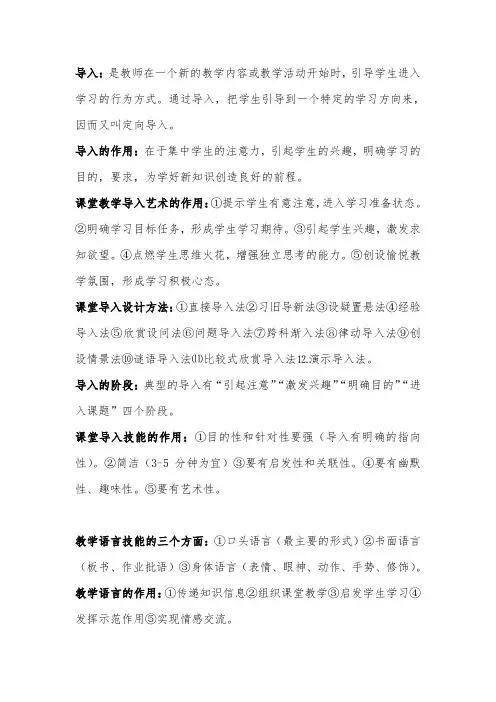
导入:是教师在一个新的教学内容或教学活动开始时,引导学生进入学习的行为方式。
通过导入,把学生引导到一个特定的学习方向来,因而又叫定向导入。
导入的作用:在于集中学生的注意力,引起学生的兴趣,明确学习的目的,要求,为学好新知识创造良好的前程。
课堂教学导入艺术的作用:①提示学生有意注意,进入学习准备状态。
②明确学习目标任务,形成学生学习期待。
③引起学生兴趣,激发求知欲望。
④点燃学生思维火花,增强独立思考的能力。
⑤创设愉悦教学氛围,形成学习积极心态。
课堂导入设计方法:①直接导入法②习旧导新法③设疑置悬法④经验导入法⑤欣赏设问法⑥问题导入法⑦跨科渐入法⑧律动导入法⑨创设情景法⑩谜语导入法⑾比较式欣赏导入法⒓演示导入法。
导入的阶段:典型的导入有“引起注意”“激发兴趣”“明确目的”“进入课题”四个阶段。
课堂导入技能的作用:①目的性和针对性要强(导入有明确的指向性)。
②简洁(3-5分钟为宜)③要有启发性和关联性。
④要有幽默性、趣味性。
⑤要有艺术性。
教学语言技能的三个方面:①口头语言(最主要的形式)②书面语言(板书、作业批语)③身体语言(表情、眼神、动作、手势、修饰)。
教学语言的作用:①传递知识信息②组织课堂教学③启发学生学习④发挥示范作用⑤实现情感交流。
教学语言的构成要素:由基本语言技能和特殊语言技能构成。
基本语言技能:包括语音、语调、语速、节奏、音量、词汇、语法等。
特殊语言技能:包括①引入语言②启迪语言③阐释语言④评核语言。
基本教学语言的特点:①规范性②科学性③艺术性。
体态语:是通过面部表情、眼神、手势、动作姿态、服饰等方式传递信息、表达情感、交流思想的一种有效的语言方式。
课堂体态语的特点:①辅助性②连续性③真实性。
课堂体态语的基本内容:①面部表情②手势③姿态语④服饰。
板书技能:包括主题技能和辅助板书。
主题板书:又称正版书,提纲掣领地反映教学内容,可以讲授要点,层次分析,论点论据,概括总结,一般出现在黑板的左半部和中部。
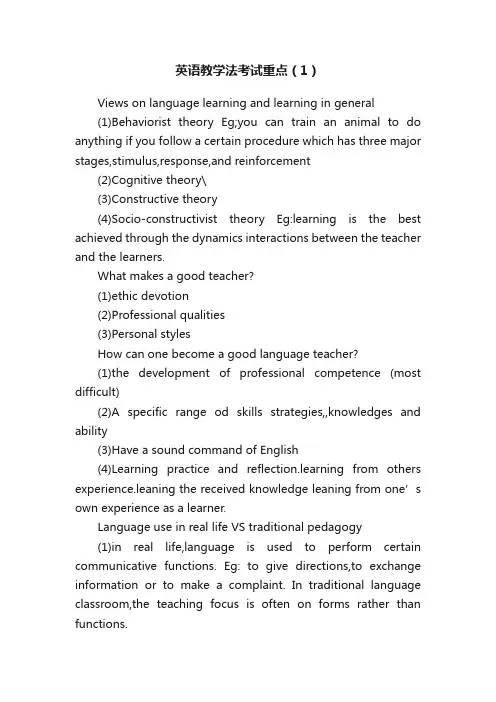
英语教学法考试重点(1)Views on language learning and learning in general(1)Behaviorist theory Eg;you can train an animal to do anything if you follow a certain procedure which has three major stages,stimulus,response,and reinforcement(2)Cognitive theory\(3)Constructive theory(4)Socio-constructivist theory Eg:learning is the best achieved through the dynamics interactions between the teacher and the learners.What makes a good teacher?(1)ethic devotion(2)Professional qualities(3)Personal stylesHow can one become a good language teacher?(1)the development of professional competence (most difficult)(2)A specific range od skills strategies,,knowledges and ability(3)Have a sound command of English(4)Learning practice and reflection.learning from others experience.leaning the received knowledge leaning from one’s own experience as a learner.Language use in real life VS traditional pedagogy(1)in real life,language is used to perform certain communicative functions. Eg: to give directions,to exchange information or to make a complaint. In traditional language classroom,the teaching focus is often on forms rather than functions.(2)For various reasons,traditional pedagogy tends to focus on two language skills and ignore the others. Eg:the grammar-translation methos emphasized on reading and writing skills and virtuallyignored listening speaking skills.(3)In reality language is always used in a certain context,but traditional pedagogy tends to isolated language from its context. Eg:when the English passive voice is introduced,the teacher always focuses on the explanation of how the objects in an active sentence is moved to the front of a passive sentence. And how the verb is changed to an auxiliary plus an -ed form of the base form of the verb.What is communicative competence ?(1)linguistic competence(2)Pragmatic competence(3)Discourse competence(4)Strategic competence(5)FluencyTask based language teachingTask definitionIs a piece of work undertaken for oneself or for others,freely or for some reward.Is an activity which requires learners to arrive at an outcome from given information through some process of thought,and which allows teachers to control and regulate that process Four components of a taskA purpose :make sure the students have a reason for undertaking the taskA context :this can be real simulated or imaginary and involves sociolinguistic issues such as the location theparticipants and their relationship,the time,and other important factors.A process;getting the students to use learning strategies such as problem solving reasoning inquiring conceptual and communicatingA product : there will be some form of outcome either visible or invisibleExercises tasksFocus form meaningSituation no situation real life situationOutcome correct form accomplishment of taskLanguage practice of assigned form choice of form and contentError immediate correction delayed correctionPrinciples for good lesson planning(1)Aims means a realistic goals for the lesson the teacher needs to have a clear idea of what he or she would like to achieve for the lesson or what outcomes are expected from the lesson Aims are not the things teachers intend to do during the lesson,but the things that students are able to do bu the end od the lesson.(2)Variety means planning a number of different types of activities.(3)Flexibility means preparing some extra and alternatives tasks and activities as the class does not always go according to the plan(4)Learnability means the contents and tasks planned for the lesson should be within the learning capabilities of the students.(5)Linkage means linked with each otherHarmer suggest the following measures for indisciplined actsand badly behaving students(1)Act immediately(2)Stop the class(3)Rearrange the seats(4)Change the activity(5)Talk to students after class(6)Create a code of behaviorDealing with errors(1)dealing with spoken errors(2)When to correct generally it is best to interrupt students during fluency work unless communication breaks down.if the students has got most of his language right but has made a trivial mistakes it is sometimes wise to let the mistakes pass if there are some common mistakes that other students might also have problems with,the teacher can take a note in his or her mind and try to do the correction after the students’ performance.(3)How to correct indirect teacher correction is encouraged to avoid damaging students’self esteem and confidence. Ask a question to invite the students to say it again with a hint of a problem. Sometimes the whole class can be invited to correct the mistakes.Characteristics of the listening process(1)spontaneity(2)Context(3)Visual clues(4)Listeners ‘s response(5)Speakers’ adjustmentA process approach to writing(1)Focus on the process of writing that leads to the final written process(2)Help students writers understand their own composing process(3)Help them built repetoires of strategies for previewing drafting and rewriting(4)Palace central importance on the process of reversion(5)Give students time to write and rewrite(6)Let the students discover what they want to say as they write(7)Give students the feedback throughout the composing process to consider as they attempt to bring their expression closer and closer to intention(8)Encourage feedback both from the instructors and peers(9)Include individual conferences between teacher and student during the process of composition。
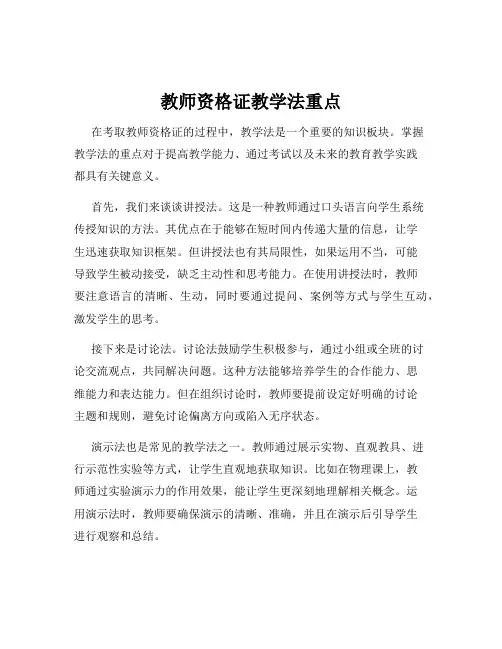
教师资格证教学法重点在考取教师资格证的过程中,教学法是一个重要的知识板块。
掌握教学法的重点对于提高教学能力、通过考试以及未来的教育教学实践都具有关键意义。
首先,我们来谈谈讲授法。
这是一种教师通过口头语言向学生系统传授知识的方法。
其优点在于能够在短时间内传递大量的信息,让学生迅速获取知识框架。
但讲授法也有其局限性,如果运用不当,可能导致学生被动接受,缺乏主动性和思考能力。
在使用讲授法时,教师要注意语言的清晰、生动,同时要通过提问、案例等方式与学生互动,激发学生的思考。
接下来是讨论法。
讨论法鼓励学生积极参与,通过小组或全班的讨论交流观点,共同解决问题。
这种方法能够培养学生的合作能力、思维能力和表达能力。
但在组织讨论时,教师要提前设定好明确的讨论主题和规则,避免讨论偏离方向或陷入无序状态。
演示法也是常见的教学法之一。
教师通过展示实物、直观教具、进行示范性实验等方式,让学生直观地获取知识。
比如在物理课上,教师通过实验演示力的作用效果,能让学生更深刻地理解相关概念。
运用演示法时,教师要确保演示的清晰、准确,并且在演示后引导学生进行观察和总结。
还有练习法,通过让学生做练习来巩固所学知识和技能。
练习的设计要有针对性和层次性,满足不同学生的需求。
同时,教师要及时给予反馈和指导,帮助学生纠正错误,提高学习效果。
情境教学法是创造具体的情境,让学生在情境中学习和体验。
比如在语文课上,通过角色扮演来感受文学作品中的情感。
这种方法能够增强学生的情感体验和实际应用能力,但情境的创设要符合教学目标和学生的实际情况。
发现法强调学生自主发现问题、解决问题。
教师在这个过程中起到引导和支持的作用。
这有助于培养学生的创新精神和自主学习能力,但对学生的基础和能力有一定要求,需要教师根据学生的情况合理运用。
除了以上这些教学法,还有探究法、读书指导法等。
在实际教学中,往往不是单一地使用某一种教学法,而是根据教学目标、教学内容和学生特点,灵活选择和综合运用多种教学法。
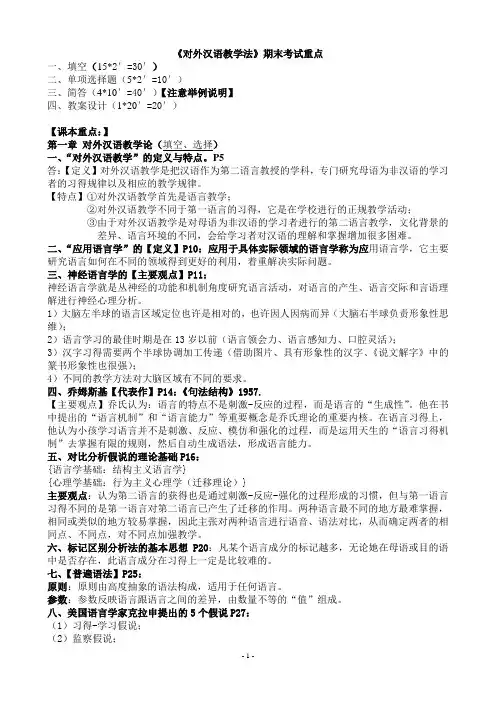
《对外汉语教学法》期末考试重点一、填空(15*2′=30′)二、单项选择题(5*2′=10′)三、简答(4*10′=40′)【注意举例说明】四、教案设计(1*20′=20′)【课本重点:】第一章对外汉语教学论(填空、选择)一、“对外汉语教学”的定义与特点。
P5答:【定义】对外汉语教学是把汉语作为第二语言教授的学科,专门研究母语为非汉语的学习者的习得规律以及相应的教学规律。
【特点】①对外汉语教学首先是语言教学;②对外汉语教学不同于第一语言的习得,它是在学校进行的正规教学活动;③由于对外汉语教学是对母语为非汉语的学习者进行的第二语言教学,文化背景的差异、语言环境的不同,会给学习者对汉语的理解和掌握增加很多困难。
二、“应用语言学”的【定义】P10:应用于具体实际领域的语言学称为应用语言学,它主要研究语言如何在不同的领域得到更好的利用,着重解决实际问题。
三、神经语言学的【主要观点】P11:神经语言学就是丛神经的功能和机制角度研究语言活动,对语言的产生、语言交际和言语理解进行神经心理分析。
1)大脑左半球的语言区域定位也许是相对的,也许因人因病而异(大脑右半球负责形象性思维);2)语言学习的最佳时期是在13岁以前(语言领会力、语言感知力、口腔灵活);3)汉字习得需要两个半球协调加工传递(借助图片、具有形象性的汉字、《说文解字》中的篆书形象性也很强);4)不同的教学方法对大脑区域有不同的要求。
四、乔姆斯基【代表作】P14:《句法结构》1957.【主要观点】乔氏认为:语言的特点不是刺激-反应的过程,而是语言的“生成性”。
他在书中提出的“语言机制”和“语言能力”等重要概念是乔氏理论的重要内核。
在语言习得上,他认为小孩学习语言并不是刺激、反应、模仿和强化的过程,而是运用天生的“语言习得机制”去掌握有限的规则,然后自动生成语法,形成语言能力。
五、对比分析假说的理论基础P16:{语言学基础:结构主义语言学}{心理学基础:行为主义心理学(迁移理论)}主要观点:认为第二语言的获得也是通过刺激-反应-强化的过程形成的习惯,但与第一语言习得不同的是第一语言对第二语言已产生了迁移的作用。
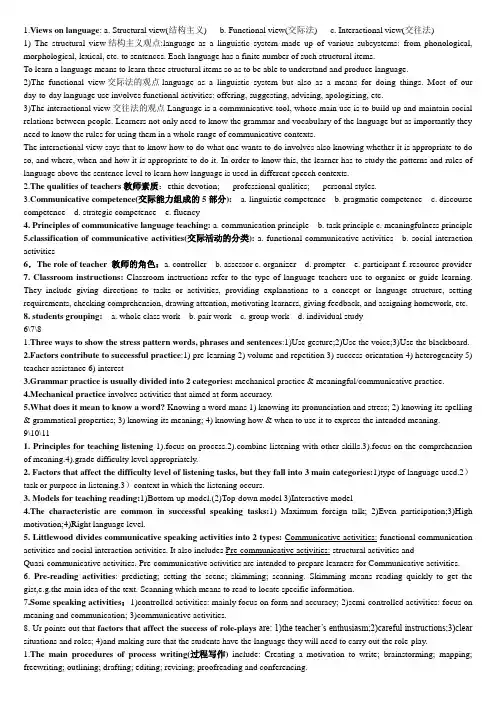
1.Views on language: a. Structural view(结构主义) b. Functional view(交际法) c. Interactional view(交往法)1) The structural view结构主义观点:language as a linguistic system made up of various subsystems: from phonological, morphological, lexical, etc. to sentences. Each language has a finite number of such structural items.To learn a language means to learn these structural items so as to be able to understand and produce language.2)The functional view交际法的观点language as a linguistic system but also as a means for doing things. Most of our day-to-day language use involves functional activities: offering, suggesting, advising, apologizing, etc.3)The interactional view交往法的观点Language is a communicative tool, whose main use is to build up and maintain social relations between people. Learners not only need to know the grammar and vocabulary of the language but as importantly they need to know the rules for using them in a whole range of communicative contexts.The interactional view says that to know how to do what one wants to do involves also knowing whether it is appropriate to do so, and where, when and how it is appropriate to do it. In order to know this, the learner has to study the patterns and rules of language above the sentence level to learn how language is used in different speech contexts.2.The qualities of teachers教师素质:ethic devotion; professional qualities; personal styles.municative competence(交际能力组成的5部分): a. linguistic competence b. pragmatic competence c. discourse competence d. strategic competence e. fluency4. Principles of communicative language teaching: a. communication principle b. task principle c. meaningfulness principle5.classification of communicative activities(交际活动的分类): a. functional communicative activities b. social interaction activities6.The role of teacher 教师的角色:a. controller b. assessor c. organizer d. prompter e. participant f. resource-provider 7. Classroom instructions: Classroom instructions refer to the type of language teachers use to organize or guide learning. They include giving directions to tasks or activities, providing explanations to a concept or language structure, setting requirements, checking comprehension, drawing attention, motivating learners, giving feedback, and assigning homework, etc.8. students grouping: a. whole class work b. pair work c. group work d. individual study6\7\81.Three ways to show the stress pattern words, phrases and sentences:1)Use gesture;2)Use the voice;3)Use the blackboard.2.Factors contribute to successful practice:1) pre-learning 2) volume and repetition 3) success-orientation 4) heterogeneity 5) teacher assistance 6) interest3.Grammar practice is usually divided into 2 categories: mechanical practice & meaningful/communicative practice.4.Mechanical practice involves activities that aimed at form accuracy.5.What does it mean to know a word? Knowing a word mans 1) knowing its pronunciation and stress; 2) knowing its spelling & grammatical properties; 3) knowing its meaning; 4) knowing how & when to use it to express the intended meaning.9\10\111. Principles for teaching listening 1).focus on process.2).combine listening with other skills.3).focus on the comprehension of meaning.4).grade difficulty level appropriately.2. Factors that affect the difficulty level of listening tasks, but they fall into 3 main categories:1)type of language used.2)task or purpose in listening.3)context in which the listening occurs.3. Models for teaching reading:1)Bottom-up model.(2)Top-down model 3)Interactive model4.The characteristic are common in successful speaking tasks:1) Maximum foreign talk; 2)Even participation;3)High motivation;4)Right language level.5. Littlewood divides communicative speaking activities into 2 types: Communicative activities: functional communication activities and social interaction activities. It also includes Pre-communicative activities: structural activities andQuasi-communicative activities. Pre-communicative activities are intended to prepare learners for Communicative activities. 6. Pre-reading activities: predicting; setting the scene; skimming; scanning. Skimming means reading quickly to get the gist,e.g.the main idea of the text. Scanning which means to read to locate specific information.7.Some speaking activities:1)controlled activities: mainly focus on form and accuracy; 2)semi-controlled activities: focus on meaning and communication; 3)communicative activities.8. Ur points out that factors that affect the success of role-plays are: 1)the teacher’s enthusiasm;2)careful instructions;3)clear situations and roles; 4)and making sure that the students have the language they will need to carry out the role-play.1.The main procedures of process writing(过程写作)include: Creating a motivation to write; brainstorming; mapping; freewriting; outlining; drafting; editing; revising; proofreading and conferencing.2. Principles can help teachers motivate students to write: 1) Make the topic of writing as close as possible to students’ life.2) Leave students enough room for creativity and imagination. 3) Prepare students well before writing. 4) Encourage collaborative group writing as well as individual writing. 5) Provide opportunities for students to share their writings. 6) Provide constructive and positive feedback. 7) Treat students’’ errors strategically. 8) Give students a sense of achievement from time to time.1.我国英语教学的六个基本原则原先所倡导的中学英语教学的基本原则:1、交际性原则2、阶段侧重原则3、语音词汇语法综合教学原则4、使用和控制使用本族语的原则5、以学生为中心的原则。
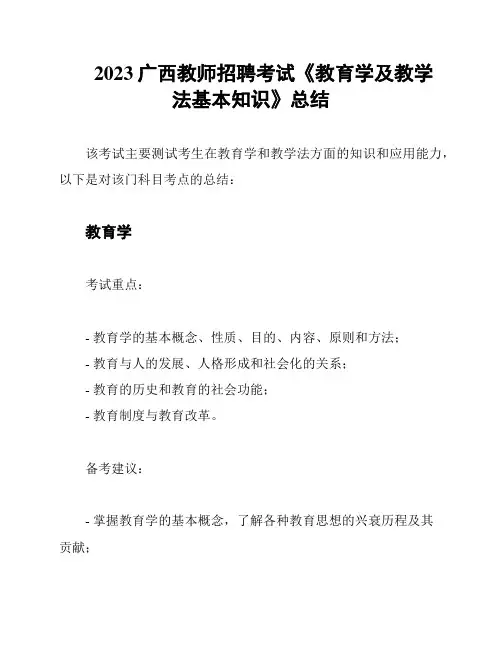
2023广西教师招聘考试《教育学及教学
法基本知识》总结
该考试主要测试考生在教育学和教学法方面的知识和应用能力,以下是对该门科目考点的总结:
教育学
考试重点:
- 教育学的基本概念、性质、目的、内容、原则和方法;
- 教育与人的发展、人格形成和社会化的关系;
- 教育的历史和教育的社会功能;
- 教育制度与教育改革。
备考建议:
- 掌握教育学的基本概念,了解各种教育思想的兴衰历程及其
贡献;
- 了解国内外教育改革的历程、经验及现状,关注教育改革的发展趋势;
- 梳理教育学的各种理论体系,并学会将这些基本理论应用到具体教学实践中。
教学法
考试重点:
- 教学法的基本概念、原则;
- 教学法的分类和特点、评价方法;
- 教学设计和教学过程的基本要素;
- 常见教学模式和教学策略。
备考建议:
- 掌握教学法的基本概念、原则及相关评价方法,了解各种教学法及其特点,能够合理使用不同的教学法;
- 学会根据教学任务选择合适的教学策略,了解案例分析法、问题教学法、讨论法等教学方法的应用;
- 不断思考如何将教学法引入到实际教学中,从而提升教学效果。
综上所述,考生在备考该科目时应该注重对教育学和教学法基本理论的掌握,并学会将理论与实践相结合,以提升自己的教育教学能力。
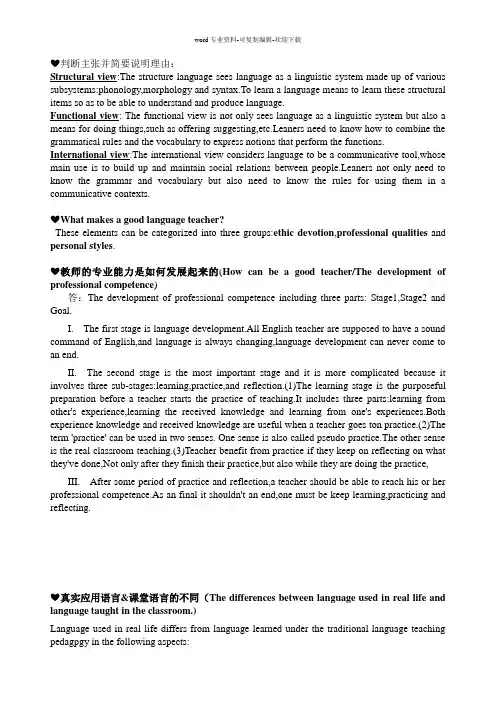
❤判断主张并简要说明理由:Structural view:The structure language sees language as a linguistic system made up of various subsystems:phonology,morphology and syntax.To learn a language means to learn these structural items so as to be able to understand and produce language.Functional view: The functional view is not only sees language as a linguistic system but also a means for doing things,such as offering suggesting,etc.Leaners need to know how to combine the grammatical rules and the vocabulary to express notions that perform the functions. International view:The international view considers language to be a communicative tool,whose main use is to build up and maintain social relations between people.Leaners not only need to know the grammar and vocabulary but also need to know the rules for using them in a communicative contexts.❤What makes a good language teacher?These elements can be categorized into three groups:ethic devotion,professional qualities and personal styles.❤教师的专业能力是如何发展起来的(How can be a good teacher/The development of professional competence)答:The development of professional competence including three parts: Stage1,Stage2 and Goal.I. The first stage is language development.All English teacher are supposed to have a sound command of English,and language is always changing,language development can never come to an end.II. The second stage is the most important stage and it is more complicated because it involves three sub-stages:learning,practice,and reflection.(1)The learning stage is the purposeful preparation before a teacher starts the practice of teaching.It includes three parts:learning from other's experience,learning the received knowledge and learning from one's experiences.Both experience knowledge and received knowledge are useful when a teacher goes ton practice.(2)The term 'practice' can be used in two senses. One sense is also called pseudo practice.The other sense is the real classroom teaching.(3)Teacher benefit from practice if they keep on reflecting on what they've done,Not only after they finish their practice,but also while they are doing the practice, III. After some period of practice and reflection,a teacher should be able to reach his or her professional competence.As an final it shouldn't an end,one must be keep learning,practicing and reflecting.❤真实应用语言&课堂语言的不同(The differences between language used in real life and language taught in the classroom.)Language used in real life differs from language learned under the traditional language teaching pedagpgy in the following aspects:(1)In real life,language is used to perform certain communication functions;in a traditional language classroom,the teaching focus is often on forms rather than functions.(2)For various reasons,traditional pedagogy tends to focus on one or two language skills and ignore others.In real language use we use all skills,including receptive skills and productive skills.(3)In reality language is always used in a certain context,but traditional pedagogy tends to isolate language from its context.❤交际教学法的目标The goal of CLT is to develop students'communicative competence,which includes both the knowledge about the language and the language about how to use the language appropriately in communicative situations.★★★交际的五个方面(名词解释or简答)There are five main components of communicative ly,linguistic competence,pragmatic competence,discourse competence,strategic competence,and fluency.Linguistic competence is concerned with knowledge itself,its form and meaning.(It involves spelling, pronunciation, vocabulary, word formation, grammatical structure,sentence structure,and semantics.It is an integral part of communicative competence.)Pragmatic competence is concerned with the appropriate use of the language in social context.(That is to say,the choice of the vocabulary and structure depends on the setting,the relative status of the speakers,and their relationships.)Discourse competence refers to one's ability to create coherent written text or conversation and the ability to understand them.(According to Hedge,also includes one's ability to initiate,develop,enter,interrupt,check,or confirm in a conversation.)Strategic competence is similar to communication strategies.It refers to strategies one employs when there is communication breakdown due to lack of resources.One can compensate for this by searching for other means of expression.Fluency means one's ability to 'link unit of speech together with facility and without strain or inappropriate or undue hesitation.❤Principles of communicative language teaching.(交际教学语言CLT原则)(1).Communication principle:Activities that involve real communication promote learning.(2)Task principle:Activities in which language is used for carring out meaningful tasks promote learning.(3)Meaningfulness principle:language that is meaningful to the learner supports the learning process.❤交际教学法&语言技能的关系(CLT and the teaching of language skills )(听说读写在交际教学法中怎样。
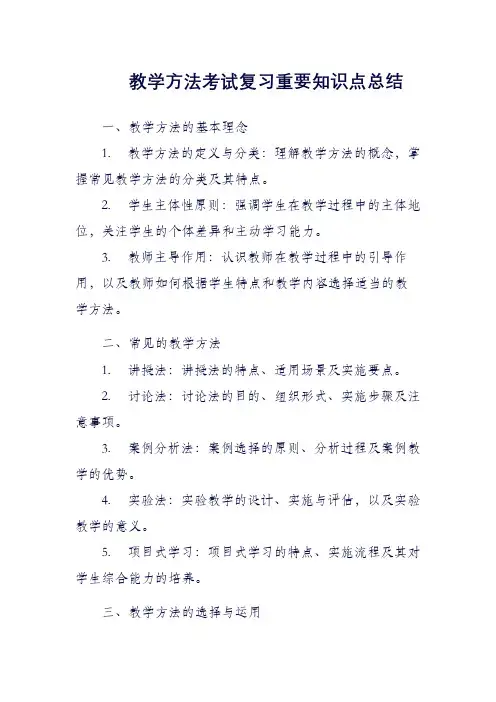
教学方法考试复习重要知识点总结一、教学方法的基本理念1.教学方法的定义与分类:理解教学方法的概念,掌握常见教学方法的分类及其特点。
2.学生主体性原则:强调学生在教学过程中的主体地位,关注学生的个体差异和主动学习能力。
3.教师主导作用:认识教师在教学过程中的引导作用,以及教师如何根据学生特点和教学内容选择适当的教学方法。
二、常见的教学方法1.讲授法:讲授法的特点、适用场景及实施要点。
2.讨论法:讨论法的目的、组织形式、实施步骤及注意事项。
3.案例分析法:案例选择的原则、分析过程及案例教学的优势。
4.实验法:实验教学的设计、实施与评估,以及实验教学的意义。
5.项目式学习:项目式学习的特点、实施流程及其对学生综合能力的培养。
三、教学方法的选择与运用1.教学方法选择的原则:根据教学目标、教学内容、学生特点等因素,选择合适的教学方法。
2.教学方法的灵活运用:掌握多种教学方法,并能根据教学实际情况进行灵活组合与运用。
3.教学方法的创新与探索:关注教学方法的最新研究成果,尝试将新的教学方法引入课堂,提高教学效果。
四、教学方法的评价与反思1.教学方法的评价标准:了解教学方法评价的目的、原则及具体评价标准。
2.教学方法的反思与改进:对教学方法进行反思,总结经验教训,提出改进措施,不断优化教学方法。
五、现代教学技术在教学中的应用1.多媒体教学:了解多媒体教学的优势、常用工具及其实施要点。
2.网络教学:掌握网络教学的特点、平台选择及教学设计。
3.信息化教学手段:熟悉信息化教学手段在教学中的应用,如在线作业、互动课堂等。
六、课堂管理与教学氛围营造1.课堂纪律管理:建立有效的课堂纪律管理制度,确保教学秩序井然。
2.课堂氛围营造:营造积极、和谐的课堂氛围,激发学生的学习兴趣和参与度。
3.学生互动与参与:设计丰富多样的教学活动,鼓励学生积极参与、主动探索。
以上是关于教学方法考试复习的重要知识点总结,考生在复习过程中应注重理论与实践的结合,了解各种教学方法的特点、适用场景及实施要点,同时关注现代教学技术的应用和课堂管理的技巧。
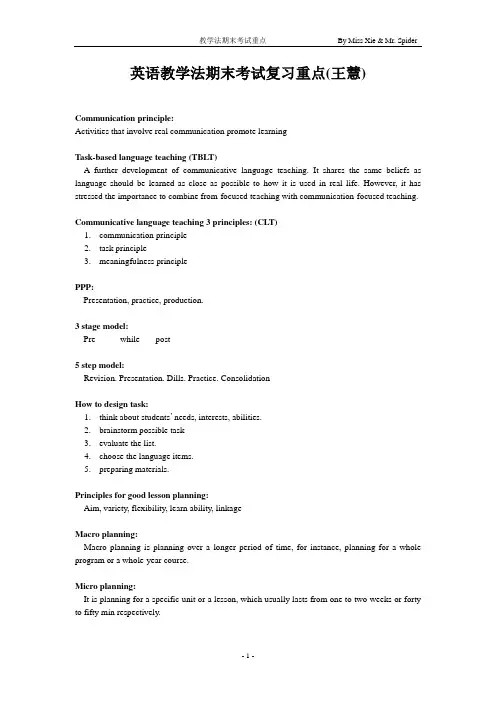
英语教学法期末考试复习重点(王慧)Communication principle:Activities that involve real communication promote learningT ask-based language teaching (TBLT)A further development of communicative language teaching. It shares the same beliefs as language should be learned as close as possible to how it is used in real life. However, it has stressed the importance to combine from-focused teaching with communication-focused teaching.Communicative language teaching 3 principles: (CLT)munication principle2.task principle3.meaningfulness principlePPP:Presentation, practice, production.3 stage model:Pre- while- post-5 step model:Revision. Presentation. Dills. Practice. ConsolidationHow to design task:1.think about students’ needs, interests, abilities.2.brainstorm possible task3.evaluate the list.4.choose the language items.5.preparing materials.Principles for good lesson planning:Aim, variety, flexibility, learn ability, linkageMacro planning:Macro planning is planning over a longer period of time, for instance, planning for a whole program or a whole-year course.Micro planning:It is planning for a specific unit or a lesson, which usually lasts from one to two weeks or forty to fifty min respectively.Component of a lesson plan:Background info, teaching aim, language contents and skills, stage and procedures, teaching aids, end of lesson summary, option activities and assignments, teachers after lesson reflection.The role of the teacher:Harmer defines the teacher’s role as controller, assessor, organizer, prompter, participant and resource- provider.Student grouping:Whole class work, pair work, group work, individual study.How to correct: --Page 87Direct teacher correction, indirect teacher correction, self-correction, peer correction, whole class correction, indirect teacher correction is encouraged rather than direct teacher correction to avoid demanding students’ self esteem and confidence.The goal of teaching pronunciation: (realistic goal)1.consistency: the pronunciation should be sooth and natural2.intelligibility: the pronunciation should be understandable to the listeners.municative efficiency: the pronunciation should help convey the meaning that isintended by the speaker.Aspects of pronunciation:Sound, rules, phonetic symbols, stress, intonation, rhythm.语音教学7步骤:1.say the sound alone.2.get students to repeat the sound in chorus.3.get individual students to repeat the sound.4.explain how to make the sound5.say the sound in a work6.contrast it with other sounds7.say the sound in meaningful contextGrammar presentation:1.the deductive method 教学演绎法2.the inductive method 推论法3.the guided discovery method 定向探索法语法练习的分类:Mechanical practice and meaningful/communicative practice.What does knowing a word involve:Pronunciation, stress, spelling, grammatical, properties, meaning, usage.A word is minimal free form vocabulary item is a word, phrase or sentence.Ways of presenting vocabulary:ing pictures, photos, video clips… to show meaning2.provide a verbal context to demonstrate meaninge synonyms or antonyms to explain meaningse lexical sets or hyponyms to show relations of words and their meaning5.translate and exemplifyWays of consolidation vocabulary:1.spot the difference2.describe and draw3.play a gamee word5.word bingo6.word association7.find synonyms and antonyms8.categoriesing word net-working the Internet resources for more ideasCharacteristics of the listening process:1.spontaneity2.context3.visual clues4.listener’s response5.speaker’s adjustmentThree teaching stages in listening:Pre-listening, While-listening and Post-listening.Principles for teaching speaking:1.balancing accuracy-based with fluency-based practies.2.contextualizing practice3.personalizing practice4.building up confidence5.maximizing meaningful interactions6.helping students develop speaking strategies.7.making the best use of classroom learning environment to provide sufficient language inputand practice for the students. (end)Designed by Miss XieTyped by Mr. Spider。
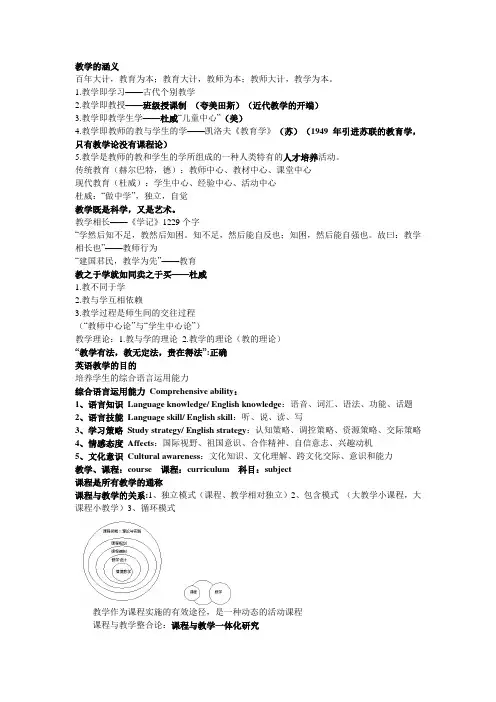
教学的涵义百年大计,教育为本;教育大计,教师为本;教师大计,教学为本。
1.教学即学习——古代个别教学2.教学即教授——班级授课制(夸美田斯)(近代教学的开端)3.教学即教学生学——杜威“儿童中心”(美)4.教学即教师的教与学生的学——凯洛夫《教育学》(苏)(1949年引进苏联的教育学,只有教学论没有课程论)5.教学是教师的教和学生的学所组成的一种人类特有的人才培养活动。
传统教育(赫尔巴特,德):教师中心、教材中心、课堂中心现代教育(杜威):学生中心、经验中心、活动中心杜威:“做中学”,独立,自觉教学既是科学,又是艺术。
教学相长——《学记》1229个字“学然后知不足,教然后知困。
知不足,然后能自反也;知困,然后能自强也。
故曰:教学相长也”——教师行为“建国君民,教学为先”——教育教之于学就如同卖之于买——杜威1.教不同于学2.教与学互相依赖3.教学过程是师生间的交往过程(“教师中心论”与“学生中心论”)教学理论:1.教与学的理论 2.教学的理论(教的理论)“教学有法,教无定法,贵在得法”:正确英语教学的目的培养学生的综合语言运用能力综合语言运用能力Comprehensive ability:1、语言知识Language knowledge/ English knowledge:语音、词汇、语法、功能、话题2、语言技能Language skill/ English skill:听、说、读、写3、学习策略Study strategy/ English strategy:认知策略、调控策略、资源策略、交际策略4、情感态度Affects:国际视野、祖国意识、合作精神、自信意志、兴趣动机5、文化意识Cultural awareness:文化知识、文化理解、跨文化交际、意识和能力教学、课程:course 课程:curriculum 科目:subject课程是所有教学的通称课程与教学的关系:1、独立模式(课程、教学相对独立)2、包含模式(大教学小课程,大课程小教学)3、循环模式教学作为课程实施的有效途径,是一种动态的活动课程课程与教学整合论:课程与教学一体化研究课程与教学关系的本质:整合课程与教学的关系:1、相互规约(辩证统一)2、相互融合课程学习方法:1.重视理论学习2.课前预习 3.课堂思考4.教学实践教学实践:1、教学录像观摩与讨论2、微格教学3、课堂试讲4、教育见习与实习5、教学技能大赛潜力potential——压力pressure ——动力impetus教学的界定:教学是教师与学生以课堂为主渠道的交往过程,是教师的教与学生的学的统一活动。
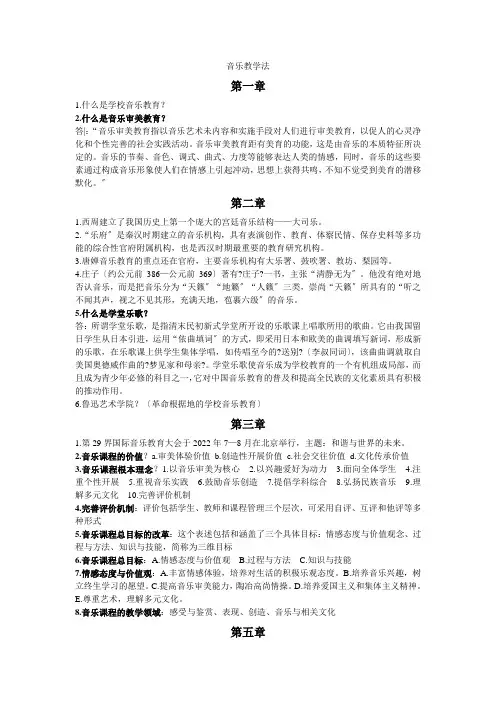
音乐教学法第一章1.什么是学校音乐教育?2.什么是音乐审美教育?答|:“音乐审美教育指以音乐艺术未内容和实施手段对人们进行审美教育,以促人的心灵净化和个性完善的社会实践活动。
音乐审美教育距有美育的功能,这是由音乐的本质特征所决定的。
音乐的节奏、音色、调式、曲式、力度等能够表达人类的情感,同时,音乐的这些要素通过构成音乐形象使人们在情感上引起冲动,思想上获得共鸣,不知不觉受到美育的潜移默化。
〞第二章1.西周建立了我国历史上第一个庞大的宫廷音乐结构——大司乐。
2.“乐府〞是秦汉时期建立的音乐机构,具有表演创作、教育、体察民情、保存史料等多功能的综合性官府附属机构,也是西汉时期最重要的教育研究机构。
3.唐婵音乐教育的重点还在官府,主要音乐机构有大乐署、鼓吹署、教坊、梨园等。
4.庄子〔约公元前386—公元前369〕著有?庄子?一书,主张“清静无为〞。
他没有绝对地否认音乐,而是把音乐分为“天籁〞“地籁〞“人籁〞三类,崇尚“天籁〞所具有的“听之不闻其声,视之不见其形,充满天地,苞裹六级〞的音乐。
5.什么是学堂乐歌?答:所谓学堂乐歌,是指清末民初新式学堂所开设的乐歌课上唱歌所用的歌曲。
它由我国留日学生从日本引进,运用“依曲填词〞的方式,即采用日本和欧美的曲调填写新词,形成新的乐歌,在乐歌课上供学生集体学唱,如传唱至今的?送别?〔李叔同词〕,该曲曲调就取自美国奥德威作曲的?梦见家和母亲?。
学堂乐歌使音乐成为学校教育的一个有机组成局部,而且成为青少年必修的科目之一,它对中国音乐教育的普及和提高全民族的文化素质具有积极的推动作用。
6.鲁迅艺术学院?〔革命根据地的学校音乐教育〕第三章1.第29界国际音乐教育大会于2022年7—8月在北京举行,主题:和谐与世界的未来。
2.音乐课程的价值?a.审美体验价值b.创造性开展价值c.社会交往价值d.文化传承价值3.音乐课程根本理念?1.以音乐审美为核心 2.以兴趣爱好为动力 3.面向全体学生4.注重个性开展5.重视音乐实践6.鼓励音乐创造7.提倡学科综合8.弘扬民族音乐9.理解多元文化10.完善评价机制4.完善评价机制:评价包括学生、教师和课程管理三个层次,可采用自评、互评和他评等多种形式5.音乐课程总目标的改革:这个表述包括和涵盖了三个具体目标:情感态度与价值观念、过程与方法、知识与技能,简称为三维目标6.音乐课程总目标:A.情感态度与价值观 B.过程与方法 C.知识与技能7.情感态度与价值观:A.丰富情感体验,培养对生活的积极乐观态度。
教学水平考试知识点总结一、教学理论基础1.1 教学原理1.1.1 教学目标的确定1.1.2 教学内容的选择1.1.3 教学方法的运用1.1.4 教学手段的使用1.1.5 教学组织的管理1.2 学习理论1.2.1 认知学派1.2.2 行为学派1.2.3 社会文化学派1.3 教学评价1.3.1 评价目的1.3.2 评价内容1.3.3 评价方法1.3.4 评价手段二、教学设计2.1 教学目标2.1.1 目标的设定2.1.2 目标的分解2.1.3 目标的阐述2.2 教学内容2.2.1 内容的选择2.2.2 内容的组织2.2.3 内容的设计2.3 教学方法2.3.1 方法的运用2.3.2 方法的调整2.3.3 方法的创新2.4 教学手段2.4.1 手段的选择2.4.2 手段的使用2.4.3 手段的改进2.5 教学评价2.5.1 评价方法的选择 2.5.2 评价指标的设定2.5.3 评价结果的分析三、学科知识3.1 语文3.1.1 文学常识3.1.2 语言知识3.1.3 作文技巧3.2 数学3.2.1 数理逻辑3.2.2 几何知识3.2.3 代数知识3.3 英语3.3.1 语法知识3.3.2 词汇量3.3.3 阅读技巧3.4 历史3.4.1 中国古代历史 3.4.2 中国近现代史 3.4.3 世界史知识3.5 地理3.5.1 自然地理知识 3.5.2 人文地理知识 3.5.3 地球科学知识3.6 物理3.6.1 力学知识3.6.2 光学知识3.6.3 热学知识3.7 化学3.7.1 元素周期表 3.7.2 化学键3.7.3 化学实验3.8 生物3.8.1 生命现象3.8.2 生物分类3.8.3 生物实验四、教育法律法规4.1 教育法4.1.1 教育法规4.1.2 教育政策4.1.3 教师职业法律责任4.2 教育心理学4.2.1 学习心理4.2.2 教学心理4.2.3 发展心理4.3 教育经济学4.3.1 教育资源4.3.2 教育投资4.3.3 教育效益4.4 教师道德规范4.4.1 教育教学规范4.4.2 教育质量评价4.4.3 教师职业操守五、学科教学法5.1 语文教学法5.1.1 课堂教学方法5.1.2 作文教学技巧5.1.3 阅读指导方法5.2 数学教学法5.2.1 问题解决方法5.2.2 数学思维培养5.2.3 数学实验设计5.3 英语教学法5.3.1 语法教学策略5.3.2 听说读写训练5.4 历史教学法5.4.1 史料解读方法 5.4.2 历史思维培养 5.4.3 历史研究技巧5.5 地理教学法5.5.1 地图阅读技巧 5.5.2 地理实地考察 5.5.3 地理现象解释5.6 物理教学法5.6.1 实验设计方法 5.6.2 物理问题解决 5.6.3 物理概念教学5.7 化学教学法5.7.1 化学实验设计 5.7.2 化学知识连贯 5.7.3 化学思维培养5.8 生物教学法5.8.1 生物实验技巧 5.8.2 生物概念培养5.8.3 生物科学研究六、教育教学实践6.1 教学案例6.1.1 教学设计案例 6.1.2 教学方法案例6.2 教学实习6.2.1 教学实习准备6.2.2 教学实习执行6.2.3 教学实习总结6.3 教学论文6.3.1 教学调研论文6.3.2 教学分析论文6.3.3 教学探讨论文以上是教学水平考试的知识点总结,希望能帮助大家更好地备考。
教材教法考试知识点数学教材教法必背知识点1.课程目标:是对某一阶段学生所应达到的规格提出的要求,反映了这一阶段的教育目的.2.数学交流:包括三个方面:①数学思想的表达,把自己的信息以某种形式(直观的或非直观的、口头的或书面的、普通语言或数学语言)表达出来②数学思想的接受,以某种方式(听、读、看等)接受来自他人的思想③数学思想载体的转换,把数学思想由一种表达方式转换成另一种表达方式。
3.课程内容:是指根据一定目标制定的某一学科中特定事实、观点、原理、方法和问题,以及处理他们的方式。
4.数学学习:学生获取数学知识、形成数学技能、发展各种数学能力的一种思维活动过程。
5.同化:把新的学习内容纳入原有认知结构中去,从而扩大原有认知结构的过程。
6.顺应:在数学学习中,已有的认知结构不能接纳新的学习内容,必须对原有认知结构进行重组,以适应新的学习内容的过程。
7.学习动机:直接推动学生进行学习的一种内部动力,是激励和指引学生进行学习的一种需要。
8.小学数学教学方法:为了达到小学数学教学目的、完成教学任务、遵循教学规律、运用教学手段而制定的师生相互作用的一整套活动方式和手段。
它表现为“教师教的方法、学生学的方法,教书的方法和育人的方法,以及师生交流信息、相互作用的方式。
“9.发现法:教师不直接把现成的知识传授给学生,而是引导学生根据教师和教科书提供的课题与材料,积极主动地思考,独立的发现相应的问题和法则的一种教学方法。
10.尝试教学法:教学过程中,不是先由教师讲,而是让学生在旧知识的基础上先来尝试练习,在尝试的过程中指导学生自学课本,引导学生讨论,在学生尝试练习的基础上,教师再进行有针对性的讲解。
11.自主学习:指学生“自我导向、自我激励、自我监控“的学习方式,这是以学生学习的具体方式为区分标准而划分的教学方式之一。
12.探究学习:从相关学科领域或现实社会生活中选择和确定研究主题,在教学中创设一种恰当的问题情境,通过学生自主、独立地发现问题、实验、操作、调查、信息搜集与处理、表达与交流等探索活动,获得知识、技能、发展情感与态度,特别是探索精神和创新能力发展的学习方式和学习过程。
第一章1、教学方法制约着学生哪些方面的发展。
P5①教学方法影响学生的精神面貌,制约学生个性心理的发展;②教学方法影响学生的学习方法,制约学生智力的发展;③教学方法影响学生的学习负担,制约学生身体的发展;2、中小学教学方法的特点是什么。
P3①发展性;②情感性;③主体性;④多样性;⑤技术性。
3、简要回答选择教学方法的依据。
P8①依据教学的具体目的与任务;②依据教材内容和学科性质、特点;③依据学生的实际情况;④依据教学原则;⑤依据教师的素养条件;⑥依据教学目标;⑦依据各种教学方法的职能、适用范围和使用条件;⑧依据学校的实际情况;⑨依据教学时间和效率的要求。
4、简要回答教学方法发展的基础趋势。
P20①由以教为重心逐渐转移到以学为重心;②教学方法单一化发展到多样化;③各种教学方法从彼此孤立发展到相互结合。
5、教学方法的选择程序答:1.明确目标;2把握精华;3比较分析;4进行筛选;5综合运用;6反馈调控6、选择教学方法应注意的问题答:1注意反馈调控优化课堂结构(注意信息反馈、着眼于教学效果);2注意灵活性和调控性; 3注意积极性与整体性;4注意科学性与艺术性; 5注意教法与学法的统一7、运用教学方法的基本要求答:1要树立完整的观点;2必须坚持以启发式为指导思想;3要善于综合地、灵活地运用教学方法,取得最优化的教学效果。
8、教学机智的表现答:1处理学生提出各种疑难问题的机敏性;2处理偶发事件的机敏性; 3处理教师自身失误的机敏性;第二章1、布鲁纳结构课程和发展教学理论的基本主张是什么。
P27①学习的过程包括“三种几乎同时发生的过程”;②认为学生的认知经历着“动作表征、映象表征、符号表征”三个发展阶段;③要让学生学科知识的基本结构;④教学促进学生智力的发展;⑤注意对儿童的早期教育;⑥注重激发学生的内部动机;⑦强调发现学习的方法。
2、简述启发教学的课堂结构模式。
P41①温故导新、提出问题;②讨论分析,阅读探究;③交流比较,终结概括;④练习巩固,反馈强化。
教学法名词解释教学方法:在教学过程中教师和学生为实现教学目的、完成教学任务而采取的各种活动方式、手段和程序的总称。
1教学氛围:指的是对教学活动产生直接影响的课堂内外部气氛、场景等。
2教学方法:在教学过程中教师和学生为实现教学目的、完成教学任务而采取的各种活动方式、手段和程序的总称。
3启发式教学:就是以学生的全面发展和主动发展为目标,通过教师的启发诱导与学生的主动探究,实现知情意和谐发展的过程。
4教学模式:是在一定的教育思想观念或教学理论指导下建立起来的较为稳定的教学活动的结构框架和活动程序。
5讲授法:是指教师运用口头语言系统连贯地向学生传授知识信息的方法。
6谈话法:又称问答法,是教师根据教学目的的要求,向学生提出问题,引导学生概括已有的知识经验,积极思考,从而使学生得出结论获得新知识和技能的方法。
7讨论法:是根据教材中的重点,难点,疑点,师生共设问题情境,在教师的指导下,由全班或小组成员相互交流个人的先看法,进而互相学习的一种教学方法。
8读书指导法:是在教师指导下学生阅读课本或课外读物,以获取知识、巩固知识、形成能力的一种方法。
9演示法:是教师在课堂上通过展示各种实物、直观教具,或进行示范性实验,让学生通过观察获得感性认识,掌握知识的一种教学方法。
10参观法:是根据教学目的和要求,组织学生到社会场所如工厂、农村、展览馆等进行参观和研究,以获得新知识或巩固和实验已学知识的教学方法。
11练习法:是学生在教师指导下,依靠自觉地控制和校正,反复的完成一定动作或活动方式,以巩固知识,运用知识,形成技能技巧或行为习惯的一种教学方法。
12实验法:是学生在教师的指导下,利用一定的仪器设备,通过条件控制引起实验的某些变化,从观察这些变化中获得知识,培养技能技巧的教学方法。
13实习作业法:是教师根据课程标准的要求,指导学生从事一定的实际工作或实际操作,将书本知识运用于实际,以获得感性知识,形成一定的技能技巧的教学方法。
一,填空1、精读课教学步骤:A由外入内b\由内到外c内外结合2、教学内容:一:语言教学a\az音位的对应性b音节的音乐性c声调的起伏性1、辨音训练2、声调训练二、词汇的教学三、语法的教学四、篇章的教学3、泛读可本质特点1、快速浏览2、猜测与跳跃4、口语课类型,1、会话、独白5、教学的一半过程:一分析阶段1确定起点状态2分析教学任务3陈诉教学目标二、实施阶段1设计有效的教学方法3、适应个别差异和民族差异的教学4、激发和维持学习动机5、教学方法的实施三、反馈阶段1测量与评估教学结果2、诊断与补救教学6、教学单位(教学课时、教学单位、教学阶段)7、教学单元:是由若干篇课文组合起来的较大的教学单位。
8、教学阶段:是由若干篇课文组合起来的较大的教学单位。
9、教学步骤10、教学单元:教学单元式指只教学活动相对集中的某个教学时段,它分为教学课时、教学单位和教学阶段。
11、教学阶段12、教学行为:与教学有关的一切具体活动,教师在教学活动中根据教学目的采取的行为。
13、话语类型(功能性话语、叙述性话语、承接性话语)1功能性话语:说话传递自己期望和意图的话语,同意句话,不同的期望和意图表达的方式不一样2承接性话语:说话根据对方话题做出原则性反映话题,意在初步表态、吧对方话题接过来再述说自己的想法3叙述性话语:说话人自己叙说事件,见闻,感受的话语14、训练类型(独白性训练、会话性训练、听力技能)1、单项训练:语言、词语、句子、成段表达2、独白训练:复述、讲故事3、会话性训练:对啊胡、语言实践、表演讨论15、训练的目的(内容、积累、语感)二、问答题1课堂就爱哦学的基本原则:(1)精讲多练的原则(2)以学生为中心的原则(3)结构、功能和文化相结合的原则(4)自觉学习和自然习得相结合的原则(5)听、说、读、写全面结合的原则(6)严格控制使用母语和媒介语的原则(7)加强直观性教学的原则16、选择适合班级学习者教材基本要求1、生词量的起点是否合适2、汉字出现的数量是否合适3、语法点跟班级学习者能否衔接,其数量速度能否接受4、课文能容是否适合学习者的需求5、课文内容长短,深浅是否适合6、教材的译注所采用的语种7、17、课堂教学准备工作:(1).备课分析教学的难点与重点-----分析教学对象------确定教学方法(2).课堂组织与管理导入课堂,排除学生心理障碍----实施有针对性的教学方法(3).课堂教学的评估测量和评估教学效果-----采取补救措施,完善教学18、课堂教学与课外实践的关系:一:课内与课外的关系1、大环境与小环境2、2、有意识学习与无意识学习二:课堂教学与社会实践及方法一、直接性配合二、2、间接性配合19、文化倒入的原则:1文化导入必须与课文内容密切有关2、摆正主次位置3、有机的,而不是外加的4、内容分散20、口语课不同阶段的训21、练侧重点是什么?1初级水平:(以单项训练为主,顺序为语音——词——语句——语段)2中级水平:(进入综合训练,逐步增强成段表达和交际的训练比重)3高级水平:(以综合训练为主,突出句群和语段的表达,加强话题提出、扩展和结束的训练)22、影响听力理解的客观基础1、听力材料2、2、听力声音推荐、3、任务特征23、写作教学的目的任务一、提高语言的写作能力二遵循写作效果的基本原则1、循序渐进与急用先学结合2、群体性与个体性结合A顾及大多数B明确写作要求C组织阅读和讨论D在班级讨论3习作性与交际性结合3、容错度与规范度结合A句点规范化B词语规范化D句子要规范24、泛读课的教学原则1一、材料的合适性1篇幅长短在300字左右3、内容深浅适当4、3、控制新词语与句式数量二、时间的限制、1、500-800字需五分钟2、800-1500需10分钟三教学的节奏性25、无汉字背景者认识汉字特点1a听说比读写容易B书写实己汉子难C利用母语识记汉字词语D句式掌握和运用以简单为主26、对外汉语突出语言教学特点1、语音,词汇,语法的特点及教学27、提高教材科懂度方法28、1;分段和归纳,29、2、难词难句的揭示;30、3、语法规则的举例;31、4问题设计;32、5、练习设计和补充;33、6、利用图表和心理图式-认知结构12.教学环节是由若干篇课文组合起来的较大的教学单位。
中学语文教学法(04579适用湖北)速记宝典简答题命题来源:围绕学科的内涵、类型、特点、优缺点、注意问题等。
答题攻略:(1)不能像名词解释那样简单,也不能像论述题那样长篇大论,但需要加以简要扩展。
(2)答案内容要简明、概括、准确,即得分的关键内容一定要写清楚。
(3)答案表述要有层次性,列出要点,分点分条作答,不要写成一段;(4)如果对于考题内容完全不知道,利用选择题找灵感,找到相近的内容,联系起来进行作答。
如果没有,随意发挥,不放弃。
考点1:简述教学法的“法”的含义。
答:教学法的"法"有两层含义。
第一层方法论的含义,即我们对语文教学规律的认识和研究。
第二层含义,是指语文教学的具体的方法、方式、技能和技巧。
考点2:简述如何学好中学语文教学法。
答:(1)首先,应当运用中学语文教学法理论去分析实际的教学活动。
(2)其次,本门课程是一门综合性极强的课程,它利用诸多学科的成果,来解决语文教学的问题,推动着语文教学的进步。
①作为学科教学理论与方法,中学语文教学法属于教育科学范畴。
教育学特别是其中的教学论是其重要的理论基础。
②教师的教和学生的学,都是心智活动的过程。
学习过程又有大量非智力因素的参与,心理科学就必然成为语文教学法的理论基础。
③语文专业的理论和知识与语文教学法联系更为密切。
④语言学的各学科和语文教学关系密切。
⑤中文专业所学的文学类各学科,也与语文教学有着密切联系。
⑥美学、美育渗透学校教育的一切方面一切环节。
语文教学是其中闪亮的一环。
考点3:简述设计教学法试验的优点。
答:(1)教学贴近儿童生活,学用结合;(2)学生能在兴趣支配下充分活动;(3)有利于训练知行合一的态度和随机应变的能力;(4)在活动中能养成学生互助合作精神;(5)活动步骤符合人们的认识历程。
考点4:简述《国文百八课》进步性的主要表现。
答:(1)编辑旨趣最重要的一点就是给予国文科以科学性,以培养学生语文技能为中心,一扫从来玄妙笼统的观念。
填空1.Nurture(empiricism经验主义):all knowledge comes fromexperience and practice, ultimately from our interaction with the environment through our reasoning or senses{environmentalist theories; the neobehaviorist; stimulus-response learning theory}.Nature(nativism先天论):generally transmitted and innate(The nativist theories; Chomsky’s innatist language acquisition theory). 2.Behavioristic(行为主义)view of language acquisition claims thatlanguage development is the process of habit formation, and the result of a set of habits. Behaviorism believes knowledge is the product of interaction with the environment through stimulus-response conditioning.3.The direct approach(直接法):developed initially as a reaction to thegrammar-translation approach in an attempt to integrate more use of the target language in instruction.(直接用目标语,不用母语)4.The audio-lingual method(听说法):based on the principles ofbehavior psychology.(顺序:听说读写;单词受限。
)5.Bottom-up/top-down listening: B-U refers to that part of the auralcomprehension process in which the understanding of the ‘heared’language is worked out proceeding from sounds to words to grammatical relationships in lexical meanings. T-D refers to the attribution of the meaning,drown from one’s own world knowledge, to language input, it involves the listener’s ability to bring prior information to bear on the task of understanding the ‘heared’language.6.Personal differences: the physical innate factors related to learners,namely age, aptitude, and intelligence.These factors are born with the learners and are not easy to be changed.选择:1.Relationship of the four skills:theories. The model forms thebasis of the Natural Approach,includes: The acquisition-learning hypothesis(习得学得假说Acquisition is a subconscious process identical in all important ways to the process children utilize in acquiring their 1st language; learning is a conscious process that results in ‘knowing about’the rules of language);The natural order hypothesis(自然顺序说);The input hypothesis(输入假说);the monitor hypothesis(监控假说,三个条件:there must be enough time;the focus must be on form and not no meaning;the learner must know the rule, students may monitor during written tasks and preplanned speech or to some extent during speech.);The affective filter hypothesis.(情感过滤假说)3.Grammar-translation method(语法翻译法):规则:1).The goal offoreign language study is to learn a language in order to read its literature or in order to benefit from the mental discipline and intellectual development that result from foreign-language study.Grammar Translation is a way of studying a language that approaches the language first through detailed analysis of its grammar rules, followed by application of this knowledge to the task of translating sentences and texts into and out of the target language. It hence views language learning as consisting of little more than memorizing rules and facts in order to understand and manipulate the morphology and syntax of the foreign language. 2).Reading and writing are the major focus; little or no systematic attention is paid to speaking or listening.3).V ocabulary selection is based solely on the reading texts used, and words are taught through bilingual word lists, dictionary study, and memorization. 4).The sentence is the basic unit of teaching and language practice. Much of the lesson is devoted to translating sentences into and out of the target language, which is a distinctive feature of the method.5).Accuracy is emphasized. Errors are not pardoned and should be corrected at once.6).Grammar is taught deductively –that is, by presentation and study of grammar rules, which are then practiced through translation exercises.7).The student’s native language is the medium of instruction.4.Total physical response(全身反映法):is a language learning methodbased on the coordination of speech and action.(James J.Asher)原则:1).2nd language learning is parallel to 1st language learning and should reflect the same naturalistic processes;2).Listening should develop before speaking;3).Children respond physically to spokenlanguage, and adult learners learn better if they do that too;4).Once listening comprehension has been developed, speech develops naturally and effortlessly out of it;5).Adults should use right-brain motor activities, which the left hemisphere watches and learns;6).Delaying speech reduces stress;7).Understanding the spoken language before developing the skills of speaking.5.Developing learning autonomy:(发展自主学习)The autonomoustakes a/an (pro-)active role in the learning process, generating, ideas and availing himself of learning opportunities, rather than simply reacting to various of learning teacher. The autonomous learner is a self-activated maker of meaning, an active agent in his own learning process. It is a constructive process that involves actively seeking meaning from events.6.Goals setting and procedures of teaching speaking(目标设定和口语教学程序):language input, structured output, communicative output.7.Structured output activities:(结构输出活动)Information gapactivities and Jigsaw activities.8.Systemic functional grammar:(系统功能语言学)represented byHallliday look at grammar from a different angle: how words, choice of words and their arrangement are used in social contexts to get message; to fulfill various functions.三个基础功能:ideational, interpersonal, textual.9.Descriptive Grammar:word-building units(morphemes) andsentence-building units(constituents) can best be described.连线1.Bruner: discovery learning theory;2.Vygotsky: social constructivist theory and zone of proximal development;3.Skinner: verbal behavior;4.Piaget: view of language acquisition;5.Ausubel: meaningful learning theory;6.Piaget: cognitive theory;7.Brown: the discourse theory;8.Searle: the speech act theory;9.Chomsky: universal grammar theory;10.Krashen: monitor model;11.Tracy Terrell and Stephen Krashen’s;natural approach;12.James J.Asher: Total physical response;13.Caleb Gattegno :The silent way;14.Georgi Lozanov : Suggestopedia15.Charles Curran: Community language learning简答1.Pre-listening stage.Strategies:Activating Existing Knowledge; BuildingPrior knowledge; Establishing Purpose; Using a Listening Guide.2.Activities to activate students’ schema:1)、Word association tasks: The students can write down as manyrelated words and phrases as possible. The teacher can summarize and write down the main ideas and use the semantic webbing method; this process will enable them to connect what they are going to listen with what they have already known.2)、Pre-questioning: Induce a selective attention strategy. We mayask the students to read the questions 1st and try to find answers.Their prior knowledge on the topic can be activated.3)、List of ideas/suggestions: This way, the students can use their listsduring the listening stage and use the words and phrases they have known, they can ask their parents for help. This can increase the likelihood of students succeeding with the task. It is a very motivating activity, especially for the lower level students.4)、Pictures and graphs reading: Pictures and graphs should beobserved and read carefully, especially with younger learners because they are good at reading pictures.3.Core reading strategies:核心阅读技巧Preview: get a sense of structure and content;Predict: use knowledge of subject matter, of the text type, about the author;Skimmer and scanning: a quick survey of the text to get the main idea, identify text structure, confirm or question predictions;Guessing from context: using prior knowledge as clues to the meanings of unknown words, instead of stopping to look them up.Paraphrasing: restate the information and the ideas in the text教案I.Teaching Aims and d emands;(教学目标)1.Knowledge objects2.Ability objects3.Moral (emotional objects) II.Teaching key points(重点)III.Teaching difficult points(难点)IV.Teaching aids(教具:multimedia, blackboard)V.Teaching Methods(教法)1.Task-based teaching and learning approach method; (任务型)2.Situational method;(情景教学法)municative method;(交际语言教学法)4.Discussion method;(讨论法)5.Group work and individual study method.(小组学习和自主学习法)VI.Procedures(过程)VII.Bb Design。